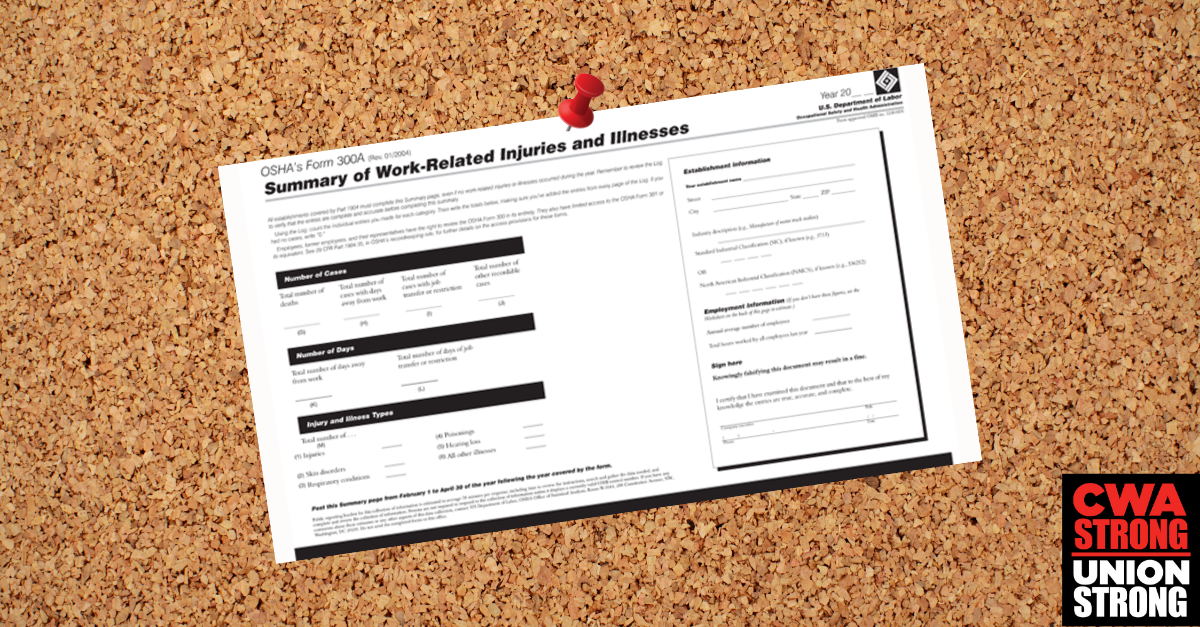
The Federal Occupational Safety and Health Act of 1970 (OSHAct) requires most employers* who employ more than ten employees to prepare and maintain records of occupational injuries, illnesses, and fatalities. The OSHA standard covering these requirements is called the OSHA Recordkeeping Standard, 29 CFR 1904.
In addition, the OSHA Recordkeeping Standard requires covered employers to post the OSHA 300A Summary of Work-Related Injuries and Illnesses in all workplaces/reporting locations from February 1 through April 30. This summary form lists the total number of work-related injuries and illnesses that occurred during the previous year and must be posted in a common area where notices to employees are usually posted. The employer’s 300A Summary must be certified/signed by the employer. Please note that if you work in a state that administers its own OSHA state plan, your state agency may use a different designation or number for the 300A Summary and other injury/illness recordkeeping forms.
The OSHA Recordkeeping standard also requires certain employers to electronically submit the 300A Summary of Work-Related Injuries and Illnesses forms for establishments with 20 or more employees but fewer than 250 employees to OSHA for the previous calendar year, including covered employers in State Plan states. The deadline to submit the electronic Summary information is March 2. The electronically submitted 300A Summary forms do not contain any personally identifiable information. A list of the industries required to annually submit OSHA 300A Summaries can be found here: 1904.41 App A.
You can find a description of the federal OSHA requirements and the forms here: https://www.osha.gov/recordkeeping/index.html.
You can see the full text of the OSHA Recordkeeping standard here: https://www.osha.gov/laws-regs/regulations/standardnumber/1904/.
Although not required to be posted, CWA local union leaders, CWA Staff, employees, former employees, and their personal representatives have the right to access other OSHA Injury and Illness records, such as the more detailed OSHA Form 300 Log of Work-Related Injuries and Illnesses, as well as parts of the OSHA Form 301 Injury and Illness Incident Report form from represented employers. The OSHA Recordkeeping standard mandates employers provide this information when requested by the end of the next business day. It is always best to make the request in writing.
The OSHA 300 Log of Work-Related Injuries and Illnesses is one tool that can be used to look at the recordable injuries and illnesses for a work location or for an employer with multiple work locations to analyze the types of injuries that are occurring, where they are occurring (department or work area), which members are getting hurt (job title), the general cause of the injuries or illnesses, and to see whether the employer is keeping accurate records. This kind of injury/illness data analysis can help inform further investigation needs and target prevention strategies and health and safety actions.
Assistance in requesting or interpreting this information is available by contacting CWA’s Deputy Director of Occupational Safety and Health, Micki Siegel de Hernández at msiegel@cwa-union.org.
*Included in OSHA’s recordkeeping regulation, certain employers are partially exempt from these reporting requirements, including: Social Advocacy Organizations; Newspaper, Periodical, Book, and Directory Publishers; Radio and Television Broadcasting; Wireless Telecommunications Carriers (except Satellite); Monetary Authorities—Central Bank; Colleges, Universities, and Professional Schools; Data Processing, Hosting, and Related Services; retail trade; and specific portions of the service industry. The full list of partially exempt industries is included in 1904 Subpart B App A.